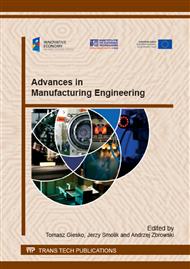[1]
W. Targański, Odzysk ciepła – przegląd metod. Materiały seminaryjne Forum Wentylacja Salon Klimatyzacja. (2009) 3-19.
Google Scholar
[2]
E. Juodis, Extracted ventilation air heat recovery efficiency as a function of a building's thermal properties. Energy and Buildings. 38 (2006) 568–573.
DOI: 10.1016/j.enbuild.2005.07.002
Google Scholar
[3]
Y. El Fouiha, P. Stabatb, P. Riviereb, P. Hoanga, V. Archambaulta, Adequacy of air-to-air heat recovery ventilation system applied in low energy buildings. Energy and Buildings. 54 (2012) 29–39.
DOI: 10.1016/j.enbuild.2012.08.008
Google Scholar
[4]
B. Maludziński, Centrale wentylacyjne rekuperacyjne – odzysk energii cieplnej. Chłodnictwo i klimatyzacja. 10 (2006) 66-68.
Google Scholar
[5]
M. Adamski, Longitudinal flow spiral recuperators in building ventilation systems, Energy and Buildings. 40 (2008) 1883–1888.
DOI: 10.1016/j.enbuild.2008.04.008
Google Scholar
[6]
J. Fernández-Seara, R. Diz, F. J. Uhía, A. Dopazo, J. M. Ferro, Experimental analysis of an air-to-air heat recovery unit for balanced ventilation systems in residential buildings. Energy Conversion and Management. 52 (2011) 635–640.
DOI: 10.1016/j.enconman.2010.07.040
Google Scholar
[7]
PN-EN 308: 2001: Heat exchangers. Test procedures for establishing performance of air to air and flue gases heat recovery devices.
DOI: 10.3403/00256870u
Google Scholar
[8]
PN-EN-13141-7: 2010: Ventilation for buildings – Performance testing of components/products for residential ventilation – Part 7: Performance testing of mechanical supply and exhaust ventilation units (including heat recovery) for mechanical ventilation systems intended for single family dwellings.
DOI: 10.3403/30102559
Google Scholar
[9]
S. Kozioł, A. Zbrowski, K. Wojtas, J. Wrona, Koncepcja systemu do badania sprawności i bezpieczeństwa wentylacyjnych układów odzysku ciepła. Problemy Eksploatacji. 1 (2012) 57-68.
Google Scholar
[10]
A. Zbrowski, S. Kozioł, P. Kosowska, Zastosowanie metod CFD w projektowaniu przepływowej komory kalorymetrycznej symulującej warunki klimatu wewnętrznego w budynku mieszkalnym. Energetyka. 11 (2012) 64-67.
Google Scholar
[11]
A. Zbrowski, S. Kozioł, K. Wojnar, Zastosowanie metod CFD w projektowaniu przepływowej komory kalorymetrycznej symulującej zimowe warunki klimatyczne. Energetyka. 11 (2012) 67-70.
Google Scholar
[12]
A. Zbrowski, S. Kozioł, M. Prymon, K. Wojtas, Analiza stanu powietrza w procesach badań systemów odzysku ciepła. TTS Technika Transportu Szynowego. 9 (2012) 597 – 608.
Google Scholar
[13]
A. Zbrowski, S. Kozioł, Badania prototypowego systemu do wyznaczania odzysku ciepła w centralach wentylacyjnych klimatyzowanych magazynów. Logistyka. 3 (2014) 7054-7065.
Google Scholar


